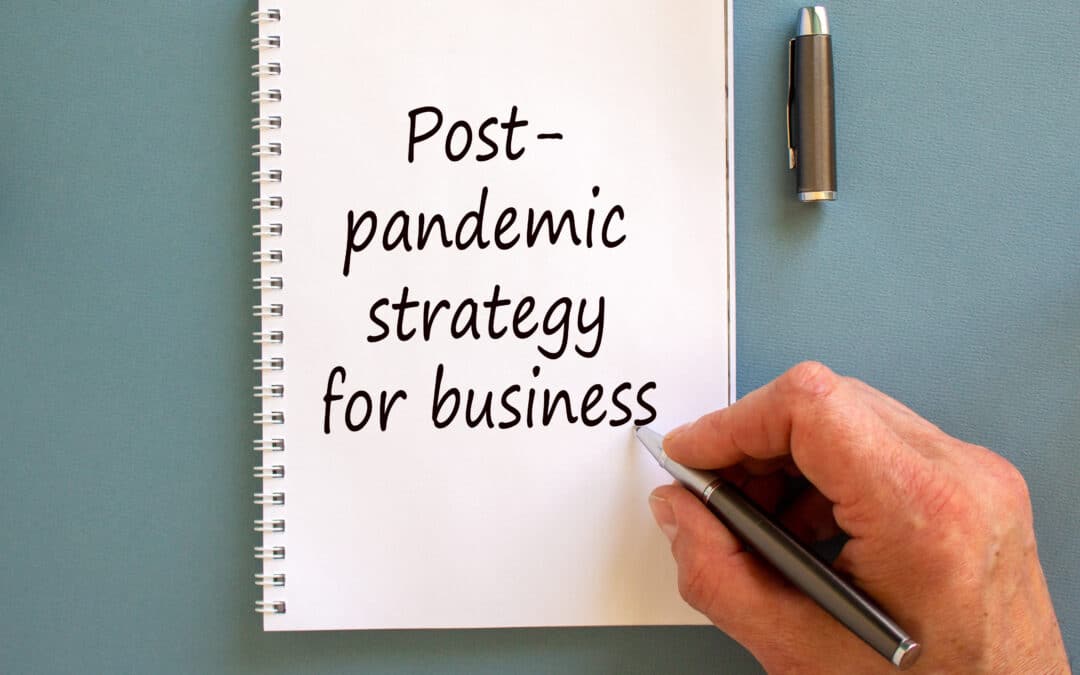When the COVID-19 pandemic hit in early 2020, virtually all businesses needed to make drastic changes to every aspect of their marketing strategy. Some businesses were quite successful and demonstrated quick and out-of-the-box thinking, while others attempted to cling to the status quo and hoped that the pandemic would fizzle out sooner rather than later. In hindsight, this obviously is not what happened.
As 2020 faded into 2021, businesses were still grappling with how to adapt their marketing strategy to fit the needs of the lingering pandemic and frequently changing restrictions. Some businesses were quite adept at this. Restaurants provided weekly dinner boxes, newly released movies became available to stream online, outdoor dining flourished and curbside pickup for all manner of services are just some of the ways that businesses found to remain relevant and top of mind.
Now that the pandemic is beginning to feel less urgent, brands have begun to look at what their post-pandemic marketing strategies might look like. Some of these strategies may involve going back to ideas that were successful prior to the pandemic, but a majority of post-pandemic marketing will see businesses holding firm to the new ideas that helped them to survive during the uncertainty of COVID-19.
In terms of post-pandemic marketing strategies, you can expect most companies to adjust several areas of their marketing strategy to better serve their customers, all who have had a very trying couple of years. In this blog article we review three pandemic take-aways that businesses can use to create a strong post-pandemic marketing strategy going forward.
Innovation And Flexibility

Brands need to work together to create a post-pandemic marketing strategy that focuses on innovation and flexibility.
Perhaps one of the biggest marketing lessons during the pandemic was that businesses who demonstrated agility and adapted and responded quickly in response to forced change performed the best. This idea of innovation is one that businesses should continue to hold firm to when creating their post-pandemic marketing strategy. Many businesses will continue curbside pickups, boxed dinners, outdoor dining, etc., especially in this period where we are just starting to emerge from our indoor cocoons and dip our toes into the outside world.
Another marketing strategy that is quite certainly here to stay is the focus on digital sales. While online shopping has been around for quite a long time, according to Elisha Hahm from W-Promote, “there will be a massive increase of 169% in e-commerce purchases from new or low-frequency users post-pandemic.” The convenience of online shopping is not one that these new consumers are likely to let go of post-pandemic, and brands should continue to have a strong online presence to meet this demand.
Remaining agile post-pandemic doesn’t mean just continuing to do what was done during the pandemic, however. It also means being prepared for whatever comes next, and to that end, one marketing strategy that businesses should adopt is to keep their budgets flexible. As Hahm states, “Budget fluidity is essential to follow demand in real time as performance data becomes available.” She goes on further to state that “part of a brand’s post-pandemic marketing strategy needs to involve built-in flexibility so that they are able to “stay ahead of the curve by reading emerging signals in customer data and respond in real time to maximize new opportunities.”
In addition to keeping budgets flexible, according to W-Promote businesses should also practice, “continuous consumer listening and demand sensing, utilize faster decision-making cycles and greater flexibility across other key areas like creative and media.”
This idea of innovation and flexibility in post-pandemic marketing feeds into all the other areas that are discussed in this blog. The world has changed because of the pandemic, but also because of increased political and social unrest. The key to staying relevant and trustworthy to your customers is for your brand to expect change and adapt quickly when it happens.
Compassion And Empathy

Taking an empathetic approach in your marketing strategy will help you to gain the trust of your target audience.
Heather Owsiacki from Iterable shares that following the pandemic there has been an “attitude shift towards relevance and social, cultural and political values, which have taken on new importance and enduring impact.” We are quite simply not living in the same world as we were before COVID-19. Unlike the pandemic, which most will agree has not resulted in many positive changes, the social and cultural shifts that we’ve begun to see are important and long overdue. It is essential for brands to acknowledge this and act on these changes in their post-pandemic marketing strategy.
Customers have started to expect that the brands they are loyal to take a stand for what is right. While it used to be acceptable, or even preferred, for brands to remain neutral with regard to whatever may be happening in the world, it is simply no longer the case and needs to be addressed explicitly in their marketing strategies.
Owsiacki found that “consumers are more likely to purchase something from a company during and after the crisis if that company has spoken out appropriately about the pandemic.” Consumers want companies to focus on solutions instead of selling, a drastic change for many brands.
She goes on to explain that “the pandemic has impacted us on an individual level worldwide, and providing empathetic communications and actions will lessen the risk of inadvertently coming off as insensitive” and to also, “think about the content and timing of your messaging; what kind of value you’re providing; the tone of your emails; and whether you’re offering the appropriate tools for support.”
Essentially, customers want their brands to stand behind great values. Harvard Business Review states that, “Growing consumer awareness and activism precipitated during the social unrest of 2020 should make brands very focused on the values they express.” They go on to say that “while quality, convenience, and price still very much matter to consumer choice, factors like sustainability, trust, ethical sourcing, and social responsibility are increasingly important to how consumers select their products and services.”
It’s important to note that fake caring will not cut it. Consumers are smart, and brands need to understand that they will see through marketing strategies that don’t come across as an authentic belief. Simply sharing a post on social media about support and activism is not enough. Consumers want to see that brands truly care about issues, and they want to see this belief put into action in all aspects of the business. This includes how you treat employees, where you donate money, your marketing materials and doing your best to be inclusive of all people. For more on practicing inclusiveness in your marketing strategy, refer to this Three Girls’ article here.
Customer-centric
Another way that post-pandemic marketing will be different is in the need for companies to hyper focus on who exactly their target audience is and what they want. Customers now expect an enormous amount from the brands they love and rely on. They have high expectations and know exactly what they want and when they want it. This need has created an environment where customer loyalty towards brands has been tested. In fact, W-Promote shares with us that, “75% of American shoppers have altered their brand preference through the pandemic.” A one-size-fits-all approach will obviously no longer suffice; customers demand greater personalization. As such, Janet Balis from the Harvard Business Review reminds us that:
“Brands must communicate in very local and precise terms, targeting specific consumers based on their circumstances and what is most relevant to them. That means truly understanding the situation on the ground, country by country, state by state, zip code by zip code. For some businesses, such as banks, restaurants, or retailers, it may even mean tailoring communications store by store. Beyond geography, we have learned marketing messages need to be personally relevant, aligned to an individual’s situation and values, as opposed to demographics, such as age and gender. Creating a personal, human connection within any commercial message requires defining consumer segments that describe people according to multiple dimensions that influence their purchasing behavior — from their psychographics to attitudinal characteristics.”
Harvard Business Review also tells us that the EY Future Consumer Index has been conducting research with individuals from 20 countries since the start of the pandemic.
During this time, they have identified five different categories of things that consumers are looking for first in a brand. These ideas are as follows, and can help businesses when they are creating their post-pandemic marketing strategy:
- “Affordability first (32% of consumers): Living within their means and budget, focusing less on brands and more on product functionality.
- Health first (25%): Protecting their health and that of their family, choosing products they trust to be safe and minimizing risks in the way that they shop.
- Planet first (16%): Trying to minimize their impact on environment and buying brands that reflect their beliefs.
- Society first (15%): Working together for the greater good, buying from organizations they find to be honest and transparent.
- Experience first (12%): Living in the moment to make the most of life, often making them open to new products, brands, and experiences.”
Taking these ideas into account, brands must identify who they are trying to reach with their marketing strategies and adapt from there. It is clear that what each consumer desires will be different, and companies cannot reach everyone with one single strategy. However, recognizing some of the things that customers are looking for can help to guide a brand’s post-pandemic marketing strategy. Balis suggests that businesses must view their marketing strategy as just the beginning of their relationship with the consumer, and consider the “processes, technologies, talent, data models, and KPI to find the right ways to align objectively around the customers’ needs – then drive change accordingly.”
In addition to customers expecting brands to know exactly what they want, they also expect that their experience will be “frictionless, anticipatory, relevant, and connected,” according to the Harvard Business Review. Your marketing strategy should be viewed in the context of the full end-to-end journey with the consumer. Brands need to keep this in mind and work backwards to discover how exactly to accomplish this.
In post-pandemic marketing, building relationships founded on trust will need to be a priority. Brands will miss a key piece of their marketing strategy if they fail to adjust their ideas to fit those more centered on the consumer and what they want. This is not to say that brands weren’t doing this pre-pandemic, but the pandemic did certainly bring a kind of personalized approach that consumers are not likely to want to relinquish anytime soon.
Bringing It All Together
There are many things that as a society we will collectively be glad to say goodbye to as the pandemic begins to wean and we see glimpses of a life without masks and fear, but a large number of pandemic marketing strategies will carry through to the post-pandemic marketing world. Remaining flexible and being able to respond in real-time to whatever is happening, building compassion and empathy into your company’s core values and truly knowing your customer and who they are will help you build a solid post-pandemic and beyond marketing strategy.
How Can We Help?
If you find that you are struggling to gain footage in the post-pandemic marketing world, please contact us at Three Girls Media, Inc. We have the flexibility to work with you and your needs, and our marketing and PR specialists are creative, think outside-the-box and strive to operate in a way that is respectful and honoring of everyone around us. We would be happy to help you in any way that we can.
Special Offer:
Sign up for a complimentary consultation during December and receive an Annual Marketing Planning Guide valued at $475! We offer a 30-minute phone consultation with our CEO, and can answer your questions and discuss your specific marketing needs - no strings attached. Call 408-218-2391 or contact us today to arrange your consultation!


